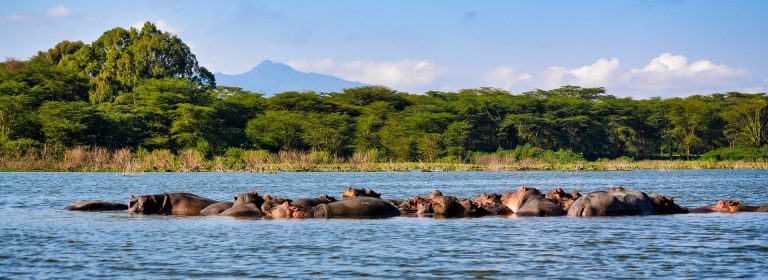Lake Nakuru National Reserve

Lake Nakuru, the world-famous haunt of flamingos, is a shallow alkaline lake in Kenya’s Rift Valley, some 62sq km (24sq miles) in extent, immediately south of Nakuru township. A first-class tarmac highway connects Nairobi with Nakuru, the 156-km (97mile) road link passing down the forested Kikuyu Escarpment with fine views over the Kedong Valley and Mounts Suswa and Longonot, then north-westwards past Lakes Naivasha and Elementaita. From Nakuru the route to the lake is well signposted. Visitors to Lake Nakuru National Park may stay in hotels in Nakuru, at the Lake Nakuru Lodge, converted from a farmhouse at the southern edge of the Park, or at Lion Hill Camp, which provides full service.
The National Park comprises the lake and it’s surrounds. The landscape is picturesque, areas of sedge, marsh and grasslands alternating with rocky cliffs and outcrops, stretches of yellow-barked acacia woodland and on the eastern perimeter rocky hillsides covered with a forest of grotesque-looking Euphorbia trees—all set against a background of hilly, broken country.
The Park was created in 1960 chiefly as a bird sanctuary. At times vast concentrations of more than a million flamingos live on the lake, forming what the famous ornithologist, Roger Tory Peterson, has described as `the most fabulous bird spectacle in the world’. But flamingos are unpredictable creatures, and not always to be found on Lake Nakuru in such vast numbers.
The lake water-levels derive from rainfall and the inflow of the tiny Njoro River fluctuates greatly. As conditions and food supplies alter, so do the numbers of flamingos present. However, even when the flamingo population is at low ebb there is always a wealth of bird-life to be observed on Lake Nakuru, both water-birds and those species which favour the habitats surrounding the lake. At present, nearly 400 species have been recorded within the area of the Park. White Pelicans can be seen in large numbers at the southern end of the Lake and on the north-eastern shore, where they come to wash, and where hides and viewing platforms have been erected. These birds have increased considerably since the alkaline-tolerant fish, Talapia grahami was introduced into the lake by the present writer and have now become a spectacular feature of the Park.
Although Lake Nakuru National Park is primarily a bird sanctuary, the number of animals to be encountered is not inconsiderable. A small herd of Hippopotamus lives among the reeds in the north-eastern corner, where springs have created a series of hippo pools. The lake shore is a good place to observe Bohor Reedbuck; these animals are often flushed from high grass or sedge in which they sleep during the day. In recent years, there has been a marked increase in the number of Bohor Reedbucks and Defassa Reedbucks in the Park. Bushbuck may be seen at the end of the acacia woodland, especially at dawn and towards dusk. Lake Nakuru is the home of a very rare bat, the Long-eared Leaf-nosed Bat (Hipposideros megalotis), a tiny orange-buff species with ears half the length of it’s body.
During 1977 an experiment was carried out to introduce a small herd of Rothschild’s Giraffe into the Lake Nakuru National Park. The animals came from the Soy area of western Kenya where the future of these giraffe is uncertain. Latest reports indicate that the experiment is a success.
Both Lesser and Greater Flamingos occur abundantly as non-breeding visitors on Lake Nakuru, the former vastly the more numerous. There is a great variety of other water birds including two interesting ducks, the Cape Wigeon, a lover of brackish waters, and the stiff-tailed Maccoa Duck.
Several species of plovers are resident, Blacksmith Plover, Spurwing Plover, Crowned Plover, Kittlitz’s Plover and Three-banded Plover; and many northern-breeding shore birds occur along the margins of the lake as winter visitors. During the spring migration their numbers are augmented by passage migrants, many of which are in full summer plumage.
Among these are flocks of Little Stints, Curlew Sandpipers, Marsh Sandpipers and Green-shanks, smaller parties of Wood and Green Sandpipers and sometimes a few Black-tailed Godwits. Birds of prey are always much in evidence, including five species of vultures, Lanner, Long-crested Eagle, Augur Buzzard, Brown and Black-chested Harrier Eagles, Fish Eagle, Gabar Goshawk and Harrier Hawk. During the winter months and on migration, further species appear, the following being common: European and Lesser Kestrels, European Black Kite, Steppe Eagle, Steppe Buzzard, and Montagu’s, Pallid and European Marsh Harriers. The line of cliffs known as `Baboon Rocks’, which rise above the western shore, is the home of a pair of majestic black Verreaux’s Eagles.
In the acacia woodlands contigous to the lake birds are numerous and the following species are characteristic: Red-chested Cuckoo, Didric Cuckoo, Lilac-breasted Roller, Grey-headed Kingfisher, Little Bee-eater, African Hoopoe, Pearl-spotted Owlet, Verreaux’s Eagle Owl, Greater Honeyguide, Grey Woodpecker, Rattling Cisticola, Grey-capped Warbler, White-browed Robin-chat, Black Cuckoo Shrike, Drongo, Grey-backed Fiscal, Tropical Boubou, White-breasted Tit, Blue-eared and Superb Starlings, Bronzy and Variable Sunbirds, Speke’s Weaver and Red-cheeked Cordon-bleu.




